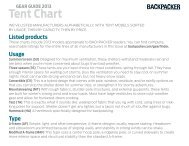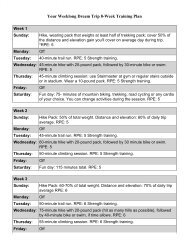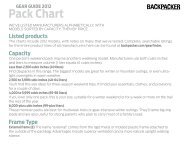BP Get Out More PDF prep
BP Get Out More PDF prep
BP Get Out More PDF prep
Create successful ePaper yourself
Turn your PDF publications into a flip-book with our unique Google optimized e-Paper software.
used gear and apparel by stopping at yard sales and thrift shops and checking<br />
bulletin boards.<br />
Know what you want before you step into the shop. Consider the<br />
following gear needs questions. Have your answers in hand when you enter<br />
the store. They’ll help you, and the salesperson,<br />
figure out what equipment is best.<br />
Packs<br />
Have you been to a big outdoors store lately<br />
If you have, you know that packs come in an<br />
array of shapes, sizes, and configurations, with<br />
designs suited for dayhiking, overnight backpacking,<br />
and expeditions. Some are made for<br />
backcountry skiers, while others boast features<br />
for fastidious climbers. Still others are tailored<br />
just for women, with specially designed shoulder<br />
straps and hipbelts, and some models appeal to<br />
ultralight fanatics. The good news is that somewhere<br />
out there, your ideal pack exists.<br />
PACK NEEDS<br />
■ What’s your price range<br />
■ Do you prefer an internal or external<br />
frame (For more on the advantages of<br />
each, see Pack Types, below.)<br />
■ What’s your torso length (See below, or check the Gear Guide, March<br />
2004, for tips on how to measure your torso.)<br />
■ Do you need a specialty shoulder harness and hip belt (such as one<br />
made specifically for women or a big or tiny waist)<br />
■ How many days is your typical trip<br />
■ Do you frequently participate in overnight winter travel<br />
BUYING A BETTER PACK<br />
1. Measure your torso. To get a proper fit, you must know your torso<br />
length. To find out, drape a soft tape measure from the seventh vertebra<br />
(the bony protrusion at the base of your neck) down along the contour of<br />
your spine to the low point between your hipbones.<br />
2. Check those hips. When trying on packs, make sure you get the hipbelt<br />
positioned properly—that is, directly on the crest of the hips, not<br />
around the waist. The majority of the load will be carried by the hipbelt, so<br />
make sure it’s comfortable<br />
and fits snugly,<br />
without slipping.<br />
3. Practice patience.<br />
Your backpack may be<br />
your most important<br />
piece of gear, so take<br />
your time with the selection<br />
process. Before you<br />
leave for the store, toss<br />
all your usual backpacking<br />
gear into a duffel<br />
bag. Once you narrow<br />
down the options, load<br />
the packs and walk<br />
around the store for 20<br />
minutes to make sure<br />
that the gear all fits<br />
inside and that the<br />
pack carries the load<br />
comfortably.<br />
4. Treat yourself.<br />
Buy the best pack you<br />
can afford as long as it<br />
fits. Durability and quality<br />
rank right behind<br />
fit as important<br />
considerations.<br />
5. Know your load.<br />
Determine what and<br />
how much you’ll be carrying.<br />
Are you planning<br />
to spend, at most, 1 or<br />
2 nights out at a time<br />
Will you be hiking in the<br />
winter For short outings<br />
in the summer, you can<br />
get by with a smaller<br />
pack, but snowy trips<br />
require more capacity,<br />
plus external gearlashing<br />
options.<br />
Pack Types<br />
External frame: For these, the packbag is mounted<br />
to the outside of a rigid frame, often made of aluminum<br />
tubes. Externals hold the pack’s weight higher<br />
than internals do, allowing you to walk in a more<br />
upright position. Externals are generally less expensive<br />
than internal frame packs.<br />
Internal frame: A frame mounted inside the packbag<br />
can be as simple as a pair of aluminum stays bent in<br />
the shape of your back or as complex as a molded<br />
sheet of rigid plastic supported by a carbon-fiber<br />
hoop. The advantages of internal frames include having<br />
a streamlined shape that resists getting hung up<br />
on brush when traveling off trail. They also ride closer<br />
to your torso and therefore resist twisting and turning<br />
when you’re scrambling over rough routes.<br />
Frameless rucksack: Take the frame out of an internal<br />
frame pack, and you have a rucksack. They are<br />
best suited for dayhiking, ski touring, ultralight backpacking,<br />
or climbing when you have little weight in the<br />
pack.<br />
Top-loading: One big opening at the top provides the<br />
only means of access to the main compartment of the<br />
bag, although many packs also have a zipper that<br />
accesses the sleeping bag compartment. Careful<br />
organization before you start loading the pack is<br />
essential so that you can stack your gear inside and<br />
keep the weight balanced properly.<br />
Panel-loading: If organization is important to you,<br />
you might like a panel loader. This type of pack features<br />
a large, horseshoe-shaped zipper that lets you<br />
peel back the front of the pack for fast, easy access<br />
to the entire main compartment. You can then meticulously<br />
organize your gear inside. The drawback: You<br />
won’t be able to cram as much stuff into it as you<br />
would a similar-size top loader.<br />
Hybrid-loading: Taking the best of both worlds and<br />
minimizing most of the drawbacks, hybrid loaders are<br />
increasingly common. You can cram in all your gear<br />
from the top, stuffing the pack completely full. Then,<br />
when you need to get something from the middle of the<br />
load, pull down an access zipper, reach in from the<br />
front (or side), and get what you need.<br />
8 GET OUT MORE!<br />
WWW.BACKPACKER.COM 9






